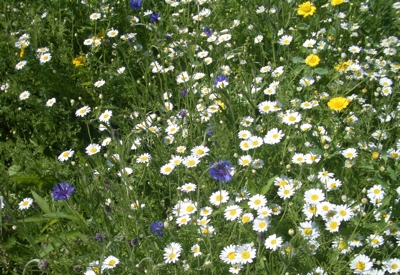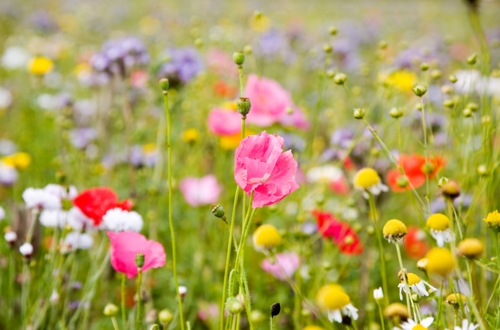Turf & Lawn Blog
Autumn Maintenance of a Wildflower Meadow
Increasingly, many gardeners are choosing to develop part of their lawn as a wildflower meadow, as well as keeping some as a beautiful patch of lawn turf. So we thought that, as well as providing advice about autumn maintenance of lawns, we should also provide a little guide to maintaining a perennial wildflower meadow.
Meadows only really need to be cut once a year. When you cut a perennial wildflower meadow depends on the type of plants and flowers within it, since you basically need to cut it when flowering has finished. So if you have spring flowering perennials, then you need to cut it around July, and with summer-flowering perennials, you should cut it in August or September. However, whatever your type of meadow, the process is more or less the same.

The best time to cut your meadow is during a dry spell, when it has not rained for a while. Not only will the grass be easier to cut, but the seed will disperse more readily, which is what you want, as it will spread your perennial species around the meadow area. The grass will be too long for a mower, so you will need to use a strimmer for small areas. For large areas, you’ll probably want to use a sickle-bar mower or motor scythe.
Once cut, leave the mowings in place for a few days, to allow the seed to disperse fully. Then rake up all the mowings and clear them. This will ensure that they don’t rot in place, and provide too much nitrogen for the soil. Perennial meadow species don’t really like very fertile soil, so you don’t want to increase fertility if you can avoid it!
At the same time, you’ll need to remove weeds, especially perennial weeds like nettles and bindweed. Either dig them out by hand, with a long thin trowel designed for the purpose, or use a spot herbicide like glyphosate, which will kill them down to the roots.

The overwhelming problem that most perennial wildflower meadows suffer is that they tend to become dominated by grass and not wildflowers. There are two main ways to combat this:
- Sow yellow rattle (Rhinanthus minor) seed throughout the meadow. This species is semi-parasitic on grass, so it will reduce the vigour of the grass, and give your flowers a chance to grow.
- Re-seed your meadow each year with any species that have not grown very well, or that you seem to be losing. Alternatively, buy and plant plugs of the relevant species in small groups, and they will then hopefully seed and spread themselves around.
Hopefully this little guide to managing your perennial wildflower meadow will help you keep it flourishing, and supporting local wildlife.
When you subscribe to the blog, we will send you an e-mail when there are new updates on the site so you wouldn't miss them.
